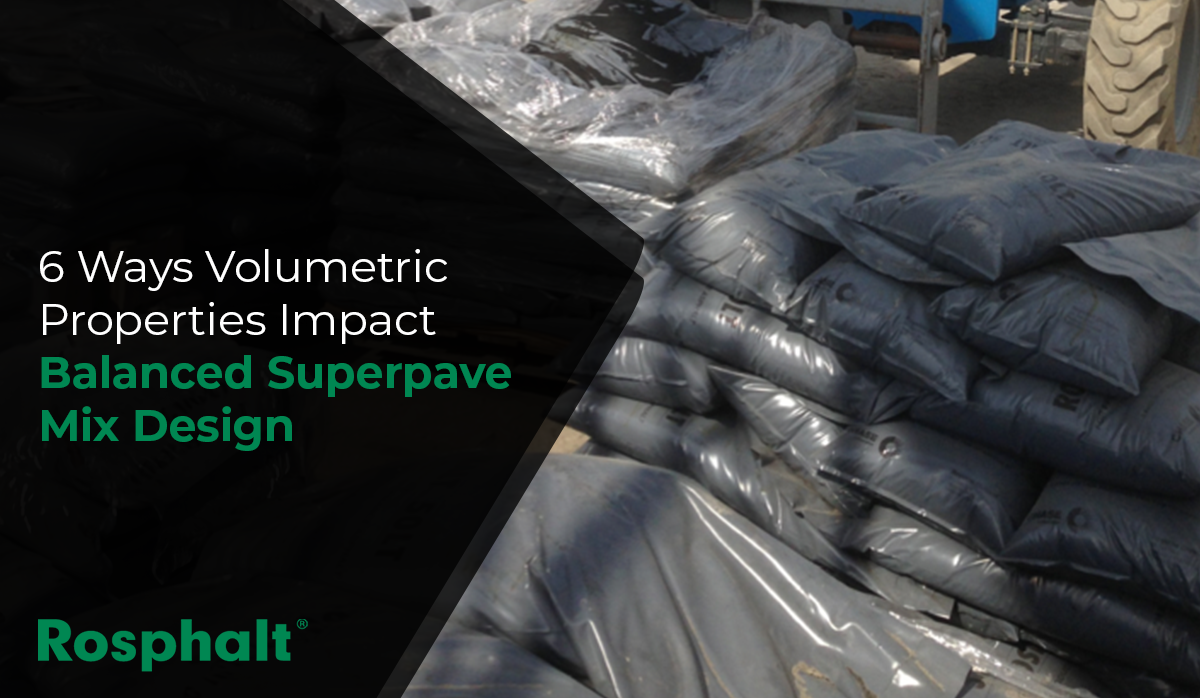Polymer additives are frequently incorporated into asphalt mix designs to improve specific...
6 Ways Volumetric Properties Impact Balanced Superpave Mix Design

Superpave (Superior Performing Asphalt Pavements) is a mix design system developed in the United States in the 1990s to produce asphalt mixes that offer superior performance and durability. It emphasizes using performance-based tests and considers various factors to design asphalt mixes tailored to specific environmental and traffic conditions.
Volumetric properties and values are the foundation of many Superpave mix design systems. A balanced mix design begins with a set criterion and then builds upon that design by adding a polymer additive. To better understand the importance of a balanced mix design, this article will explain why volumetric properties are crucial in an asphalt mix design and how they directly impact the performance and durability of the resulting pavement.
What are Volumetric Properties for Mix Design?
Volumetric design properties for HMA are a conjunction of several factors. To name a few, we often look at:
- Air voids (Va)
- Voids in Mineral Aggregate (VMA)
- Voids Filled with Asphalt (VFA)
To explain these concisely, we will look at definitions presented by the Washington State Department of Transportation.1 Air voids refer to "The total volume of the small pockets of air between the coated aggregate particles throughout a compacted paving mixture". Even after the mix is compacted, air is expected within the mixture, so air voids represent the bulk total of air present in the final composition. The higher the concentration of air voids in a mix, the more permeable a surface may be. To some degree, air voids allow for tolerance in the natural expansion and contraction of materials due to changing temperatures. When the concentration of air voids is too high, however, surfaces become increasingly permeable and are negatively affected by the intrusion of water, damaging the internal structure of the mix and shortening the service life of the material.
Voids in the mineral aggregate are "the intergranular void space between the aggregate particles of a compacted paving mixture that includes the air voids (Va), and the effective binder content." In plain terms, this represents a summation of the air voids found in a mixture and the asphalt binder present in the composition (specifically the portion of asphalt that is not absorbed by the aggregate).
Lastly, the voids filled with asphalt are "the voids in the mineral aggregate (VMA) filled with binder". This is the same concentration of asphalt binder used in the mineral aggregate calculation, the amount of asphalt present that was not absorbed into the aggregate.
The combination of these elements works together to inform the volumetric properties for hot-mix asphalt formulas. It's important to note that these are not the only influencing factors for volumetric properties, but they do accurately represent the types of considerations made when evaluating balanced mix design formulations.
Related Article: Managing Rut and Shove on Bridge Decks and Roadways
1. WSDOT SOP 732: Volumetric Design for Hot-Mix Asphalt (HMA). WSDOT Materials Manual M 46-01.44, Jan. 2024
6 Asphalt Performance Indicators Affected by Volumetric Properties
Volumetric properties include the proportions of the various components in the mix, such as aggregates, asphalt binders, and air voids. These components are critical to the overall performance of a superpave balanced mix design system and have an impact on the following:
1) Density and Compaction
Achieving the correct air void content and density is essential to ensure the asphalt pavement's durability and resistance to cracking. If the mix has too many air voids, it may become susceptible to moisture infiltration and premature wear. Conversely, if it's too dense, it can lead to rutting and reduced fatigue resistance.
2) Stability and Strength
Volumetric properties influence the pavement's structural stability and load-bearing capacity. Properly designed mixes with the right proportions of aggregates and binders will have the strength to withstand traffic loads and resist deformation.
3) Durability
The mix's ability to resist aging, temperature fluctuations, and environmental factors depends on its volumetric properties. An optimized mix design can enhance the pavement's resistance to cracking, raveling, and other forms of distress.
4) Performance
Volumetric properties impact pavement performance, including skid resistance, noise reduction, and smoothness. A well-designed mix can lead to a safer and more comfortable driving experience.
5) Cost-Effectiveness
By optimizing the volumetric properties, engineers can achieve the desired performance characteristics while minimizing costly materials like asphalt binders. This helps control construction costs.
6) Environmental Impact
Proper mix design can also contribute to sustainability efforts by reducing the amount of raw materials required and the carbon footprint associated with asphalt production and transportation.
Related Article: Benefits of Polymer Mix Design in an Asphalt System
A Superpave mix design system aims to produce asphalt pavements that are better suited for environmental and traffic conditions and have improved durability and longevity. This results in reduced maintenance and repair costs over the life of the pavement. It is important to consider these critical components and performance-based testing criteria when constructing a Superpave design.
Contact your Chase Corporation representative for assistance with the Bridge & Highway product solutions for your projects.






